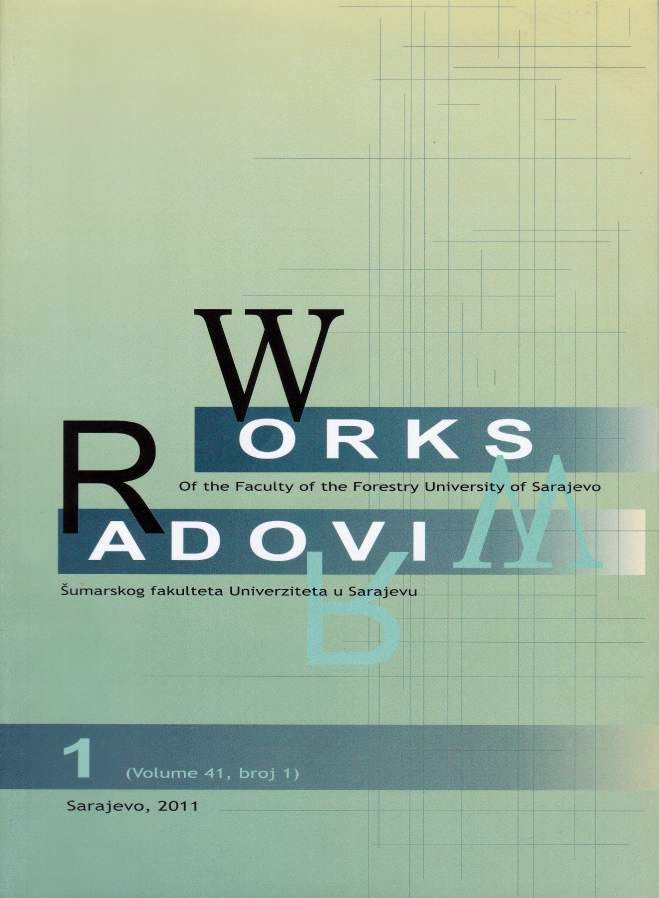ZDRAVSTVENO STANJE URBANOG DRVEĆA SARAJEVA S POSEBNIM OSVRTOM NA ŠTETE OD SNIJEGA
DOI:
https://doi.org/10.54652/rsf.2011.v41.i1.143Ključne riječi:
health status, urban trees, damages caused by snow, linking up of biotic and abiotic factorsSažetak
UDK 630*4:712(497.6 Sarajevo)
This paper analyzes the health status of trees in the avenues of the city of Sarajevo. Special attention is paid to abiotic harmful influences, snow precipitation and mechanical damage of trees, as the initial factors of destabilization of their health status.
Sarajevo area is characterized by a moderate continental climate occurring as a result of the influence of central European climate from the north and the Mediterranean climate from the south and of the variety of the terrain. This type of climate is characterized by hot summers and relatively cold winters. Because of severe thermal influence of the Adriatic Sea autumn is warmer than spring. Distribution of precipitation in Sarajevo is characterized by summer (primary) and autumn (secondary) peaks. Specific weather conditions in this area, in some years, result in early or late snowfall the consequences of which are damages of vegetation cover.
The results of this research confirmed significant damages of the trees resulted from the adverse effects of snow in October 2009 (branches fractures, split of the stem and fracture of tree crowns). The resulting injuries are suitable openings for the penetration of rot causing microorganisms (fungi and bacteria) and colonization of insects which is why we can expect further deterioration in the health status of trees in the future. The paper suggests activities the implementation of which can reduce these harmful effects of biotic factors.
Downloads
References
BEUS, V. (2009): Katastrofalni snjegolomi drveća u urbanom zelenilu Sarajeva. Naše šume, 16-17.
DAUTBAŠIĆ, M.; USČUPLIĆ, M. I TREŠTIĆ, T. (2004): Zdravstvena slika stabala lipe u aleji “Vilsonovo šetalište” u Sarajevu. Drugi Simpozij poljoprivrede, veterinarstva, šumarstva i biotehnologije. Bihać, Knjiga sažetaka, str. 147.
DIMINIĆ, D., HRAŠOVEC, B. (2005): Uloga bolesti i štetnika pri odabiru drveća u krajobraznoj arhitekturi. Agronomski glasnik, 67(2-4): 309–325.
JACKSON, M.C. (1977): A method for estimating the probability of occurrence of snow water equivalents in the United Kingdom. Hydrological Sciences Bulletin 22: 127-142.
KANTIĆ S., MUJEZINOVIĆ O., DAUTBAŠIĆ M. I TREŠTIĆ T. (2009): Istraživanje minera lista na zelenim površinama urbanih prostora. VI Simpozijum o zaštiti bilja u BiH, Tuzla, Zbornik rezimea, str. 23-24.
LJUJIĆ–MIJATOVIĆ T. I MRDOVIĆ A. (1988): Proizvodnja cvijeća i ukrasnog bilja, Univerzitetska knjiga, Sarajevo.
MATOŠEVIĆ, D. (2003): Štetna entomofauna drvenastih biljnih vrsta urbanog zelenila grada Zagreba. Magistarski rad. Zagreb: Šumarski fakultet.
MATTHEWS, J.D. (1989): Silvicultural systems. Oxford. 284 p.
MEGAHAN, W.F. I STEELE, R. (1987): An approach for predicting snow damage to ponderosa pine plantations. Forest Science 33(2): 485-503.
NOROKORPI, Y., I KÄRKKÄINEN, S. (1985): Maaston korkeuden vaikutus puusto- ja kasvupaikkatunnuksiin sekä tykkytuhoihin Kuusamossa. Summary: The effect of altitude on stand and site characteristics and crown snow-load damages Kuusamo in Nothern Finland. Folia Forestalia 632. 26 p. (In Finnish).
NYKÄNEN, M.L., PELTOLA, H., QUINE, C., KELLOMÄKI, S. I BROADGATE, M. (1997): Factors affecting snow damage of trees with particular reference to European conditions. Silva Fennica 31: 193–213.
PELLIKKA, P. I JÄRVENPÄÄ, E. (2003): Forest stand characteristics and wind and snow induced forest damage in boreal forest. In Ruck, B., Kottmeier, C., Mattheck, C., Quine, C. & Wilhelm, G. (eds.). Proceedings of the International Conference: Wind Effects on Trees. Published by Lab Building, Environment Aerodynamics, Institute of Hydrology, University of Karlsruhe, Germany. p. 269–276.
PELTOLA, HNYKÄNEN, M-L. I KELLOMÄKI, S. (1997a): Model computations on the critical combination of snow loading and windspeed for snow damage of Scots pine, Norway spruce and birch sp. at stand edge.
PERTTILÄ, P. (1987): Myrsky- ja lumituhojen esiintyminen sähkölinjoilla. Inventointi ja käsittelyohjeet. Metsänarvioimistieteen pro gradu-tutkielma. Helsingin yliopisto. 63 p. (In Finnish).
PETERSON, C.J. (2004): Within-stand variation in windthrow in southern boreal forests of Minnesota: Is it predictable? Canadian Journal of Forest Research 34: 365– 375.
ROTTMANN, M. (1985): Schneebruchschäden in Nadelholzbeständen. Beiträge zur Beurteilung der Schneebruchgefährdung, zur Schadensvorbeugung und zur Behandlung schneegeschädigter Nadelholzbestände. J.D. Sauerlander's Verlag, Frankfurt am Main. 159 p.
SCHÖNENBERGER, W. (2002): Windthrow research after the 1990 storm Vivian in Switzerland: objectives, study sites, and. projects. Forest Snow Landscape Research 77: 9–16.
SOLANTIE, R. (1994): Effects of weather and climatological background on snow damage of forest in southern Finland in November 1991. Silva Fennica 28: 203–211.
TOMICZEK, C., DIMINIĆ, D., CECH, T., HRAŠOVEC B., KREHAN H., PERNEK, M., PERNY, B. (2008): Bolesti i štetnici urbanog drveća. Jastrebarsko, Zagreb: Šumarski institut, Šumarski fakultet.
TREŠTIĆ T., DAUTBAŠIĆ M., MUJEZINOVIĆ O. (2008): Zdravstveno stanje zelenila na području Vogošće. Društvo za zaštitu bilja u BiH, 5. Simpozij o zaštiti bilja u BiH, Sarajevo, Zbornik rezimea, str. 54.
TREŠTIĆ T., DAUTBAŠIĆ M., MUJEZINOVIĆ O. I LIKIĆ A. (2007): Uticaj oštećenosti stabala na opće zdravstveno stanje sastojine. IV Simpozijum o zaštiti bilja u BiH, Teslić, Zbornik rezimea, 2007.
TREŠTIĆ, T., USČUPLIĆ, M., DAUTBAŠIĆ, M., KUNOVAC, S. I PONJAVIĆ, M. (2003): Sistem praćenja štetočina i uzročnika bolesti na šumskom i urbanom zelenilu. Prvi simpozij poljoprivrede, veterinarstva i šumarstva “Strategija razvoja domaće proizvodnje”. Neum. Zbornik radova, str 213-220
VALINGER, E. I LUNDQVIST, L. (1994): Reducing wind and snow induced damage in forestry. Sveriges lantbruksuniversitet, Institutionen för skogskötsel, Rapporter 37. 11 p.
VALINGER, E. LUNDQVIST, L. BONDESSON, L. (1993): Assessing the risk of snow and wind damage from tree physical characteristics. Forestry 66(3): 249-260.
WILLISTON, H.L. (1974): Managing pines in the ice-storm belt. Journal of Forestry 72(9): 580-582.
ZAR, H. J., (1996): Biostatistical analisys. Prentice-Hall Internacional, Inc.,USA.
ZHU, J., LI, X., LIU, Z., CAO, W., GONDA, Y. I MATSUZAKI, T. (2006): Factors affecting the snow and wind induced damage of a montane secondary forest in northeastern China. Silva Fennica 40(1): 37–51.






















